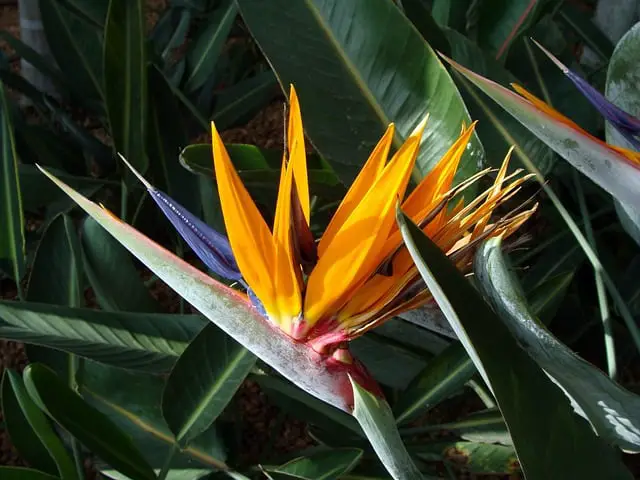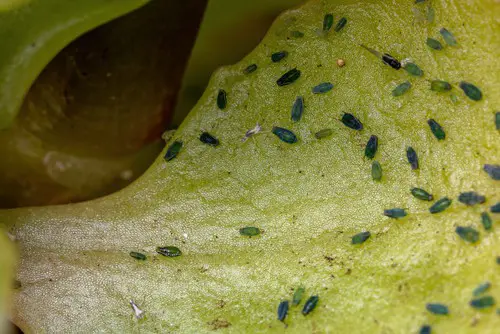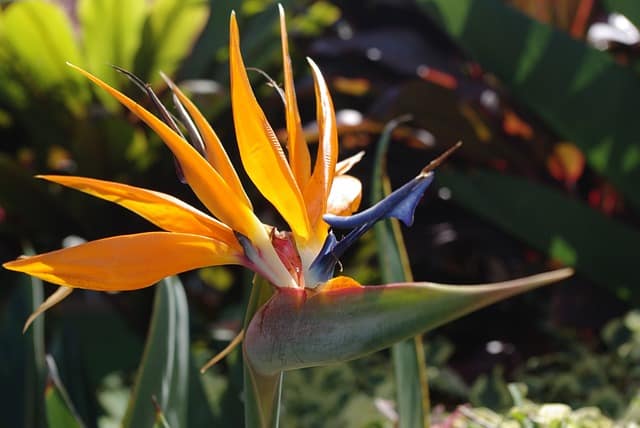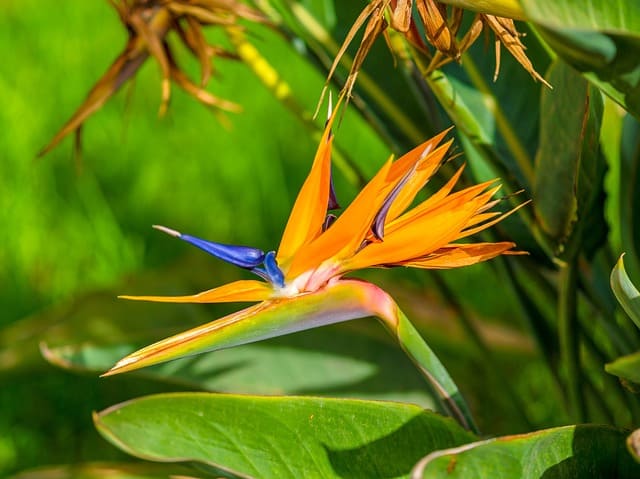The Bird of Paradise plant is a popular indoor plant that is known for its beautiful, tropical foliage. However, one common issue that many plant owners face is the drooping of the plant’s leaves. This can be a cause for concern, as it may indicate that the plant is not receiving the proper care it needs to thrive.
Understanding the Bird of Paradise plant is key to identifying the causes of drooping. This plant is native to South Africa and is known for its large, vibrant flowers that resemble a bird in flight. The plant requires a lot of light and moisture to thrive, and it is important to keep the soil consistently moist to prevent drooping.
When the leaves of the Bird of Paradise plant start to droop, it could be a sign that the plant is not receiving enough water, or that it is being exposed to too much direct sunlight.
If you notice that your Bird of Paradise plant drooping, it is important to take action to revive it. This may involve adjusting the amount of water the plant is receiving, or moving it to a location with less direct sunlight. With proper care, it is possible to revive a drooping Bird of Paradise plant and restore it to its former glory.
Key Takeaways
- Understanding the Bird of Paradise plant is key to identifying the causes of drooping.
- Proper watering and light exposure are crucial for preventing drooping.
- With proper care, it is possible to revive a drooping Bird of Paradise plant.
You might also like these other related posts:
Understanding the Bird of Paradise Plant

The Bird of Paradise plant, also known as Strelitzia reginae, is a tropical evergreen native to South Africa. This plant is known for its striking flowers that resemble the head of a bird. The plant can grow up to 5 feet tall and 3 feet wide, making it a popular choice for indoor and outdoor gardens.
The Bird of Paradise plant is a hardy plant that can tolerate a wide range of temperatures, soil types, and light conditions. It prefers bright, indirect light and well-draining soil. The plant can also tolerate some drought, but it should be watered regularly during the growing season.
In its natural habitat, the Bird of Paradise plant grows in full sun to partial shade and prefers moist soil. The plant is commonly found in coastal areas and riverbanks. It is also known to grow in rocky areas and on steep slopes.
The Bird of Paradise plant is a slow grower and can take several years to reach maturity. It is important to note that the plant can be toxic to pets and humans if ingested, so it should be kept out of reach.
Bird of Paradise Plant Drooping – 5 Common Problems
Bird of Paradise plants are known for their striking beauty and lush foliage. However, if you notice that your plant’s leaves are drooping, it could be a sign that something is wrong. Here are some common causes of drooping and how to fix them.
1. Overwatering and Underwatering
One of the most common reasons for drooping leaves in Bird of Paradise plants is overwatering or underwatering. Overwatering can cause the roots to rot, leading to drooping leaves and a general lack of vigor. Underwatering, on the other hand, can cause the leaves to wilt and droop due to a lack of water.
To fix this issue, make sure to water your plant only when the top inch of soil is dry to the touch. Avoid letting the plant sit in standing water, as this can lead to root rot.
2. Inadequate Sunlight
Bird of Paradise plants thrive in bright, indirect sunlight. If your plant is not getting enough light, it may start to droop and wilt. Make sure to place your plant in a location that gets plenty of bright, indirect sunlight.
3. Temperature and Humidity Issues
Bird of Paradise plants prefer warm, humid conditions. If the temperature is too low or the humidity is too low, the leaves may start to droop. Make sure to keep your plant in a warm, humid location, such as a bathroom or near a humidifier.
4. Poor Soil and Drainage
Bird of Paradise plants require well-draining soil to thrive. If the soil is too heavy or does not drain well, the roots may become waterlogged, leading to drooping leaves. Make sure to use a well-draining soil mix and avoid overwatering.
5. Pests and Diseases

Pests and diseases can also cause drooping leaves in Bird of Paradise plants. Common pests include spider mites, mealybugs, and scale insects. Diseases such as root rot and leaf spot can also cause drooping leaves.
To prevent pests and diseases, make sure to keep your plant clean and free of debris. Regularly inspect your plant for signs of pests or diseases and treat them promptly if you notice any issues.
Signs of a Drooping Bird of Paradise Plant
Bird of paradise plants are tropical plants that are popular for their vibrant flowers and large leaves. However, they can sometimes droop or wilt, which can be a sign of underlying problems. In this section, we will discuss the signs of a drooping bird of paradise plant, including leaf changes, root changes, and plant posture.
1. Leaf Changes
One of the most common signs of a drooping bird of paradise plant is changes in the leaves. The leaves may start to wilt, curl, or turn black or brown. In some cases, the edges of the leaves may start to brown or curl up, which can be a sign of underwatering.
Overwatering can also cause the leaves to turn yellow or brown and fall off. If the leaves are turning black or brown, it could be a sign of a fungal or bacterial infection.
2. Root Changes
Another sign of a drooping bird of paradise plant is changes in the roots. If the roots are rotting or damaged, the plant may start to wilt or droop. Overwatering is a common cause of root rot, which can cause the roots to turn black or brown and become mushy. Underwatering can also cause the roots to dry out and become brittle, which can lead to wilting.
3. Plant Posture
Finally, the posture of the plant can also be a sign of drooping. If the plant is leaning to one side or has a wilted appearance, it could be a sign of underwatering or overwatering. In some cases, the plant may also appear to be top-heavy or have a droopy appearance, which can be a sign of a lack of nutrients or poor soil quality.
Reviving a Drooping Bird of Paradise Plant
If you notice that your Bird of Paradise plant is drooping, there are several things you can do to revive it. Here are some solutions to help you get your plant back to its healthy state.
1. Adjusting Watering Practices

One common cause of drooping Bird of Paradise leaves is overwatering or underwatering. To determine whether your plant is getting enough water, check the soil moisture level. Stick your finger into the soil about an inch deep. If the soil feels dry, it’s time to water your plant. If the soil is still moist, wait a few more days before watering again.
2. Modifying Light and Temperature
Bird of Paradise plants need bright, indirect light to thrive. If your plant is not getting enough light, it may become weak and droopy. Move your plant to a brighter location, but avoid direct sunlight, which can scorch the leaves.
Temperature can also affect the health of your plant. Bird of Paradise plants prefer warm temperatures between 60 and 70 degrees Fahrenheit. If the temperature drops too low, the plant may become stressed and droop. Keep your plant away from cold drafts and air conditioning vents.
3. Improving Soil and Drainage
Bird of Paradise plants need well-draining soil. If the soil is too heavy and retains too much moisture, the roots may become waterlogged and the plant may droop. Consider repotting your plant in a well-draining soil mix.
4. Pest and Disease Treatment
Pests and diseases can also cause Bird of Paradise plants to droop. Check your plant for signs of pests such as spider mites, mealybugs, or scale insects. If you notice any pests, treat your plant with an insecticide.
Diseases such as root rot or fungal infections can also cause drooping. If you suspect a disease, remove any affected leaves and treat your plant with a fungicide.
By following these solutions, you can revive your drooping Bird of Paradise plant and help it return to its healthy state.
Preventive Measures
To prevent your Bird of Paradise from drooping, there are several measures you can take. Proper care and maintenance, choosing the right pot and soil, and monitoring for pests and diseases are all important factors in preventing drooping.
Proper Care and Maintenance
Proper care and maintenance are crucial to keeping your Bird of Paradise healthy and strong. This includes providing the right amount of water, light, and nutrients. Overwatering can lead to root rot, while underwatering can cause the leaves to droop.
The plant should be watered when the top inch of soil is dry to the touch. It is also important to provide the plant with bright, indirect light. Too much direct sunlight can scorch the leaves, while too little light can cause them to droop. Finally, regular fertilization with a balanced fertilizer can help keep the plant healthy and prevent drooping.
Choosing the Right Pot and Soil

Choosing the right pot and soil is also important in preventing drooping. The pot should be large enough to accommodate the plant’s root system, but not so large that it retains excess water.
A pot with drainage holes is also important to prevent water from accumulating in the soil. The soil should be well-draining to prevent root rot, and should also be rich in nutrients to support the plant’s growth.
Monitoring for Pests and Diseases
Monitoring for pests and diseases is another important preventive measure. Pests such as spider mites and mealybugs can damage the plant and cause the leaves to droop. Regular inspection of the plant and treatment with insecticidal soap or neem oil can help prevent infestations.
Diseases such as root rot and leaf spot can also cause drooping. Proper watering and soil drainage can help prevent these diseases from taking hold.
When to Consider Repotting
Recognizing the Need for Repotting
Bird of paradise plants need to be repotted every two to three years. Signs that a bird of paradise plant needs to be repotted include:
- Roots protruding from the drainage holes
- Slow growth
- Wilting leaves
- Yellowing leaves
- Soil drying out too quickly
- The plant becoming top-heavy
- The plant tipping over easily
If a bird of paradise plant is displaying any of these signs, it is time to consider repotting.
Steps for Successful Repotting
When repotting a bird of paradise plant, it is important to follow these steps for successful repotting:
- Choose a pot that is one size larger than the current pot. The new pot should have drainage holes and be made of a material that will not break easily.
- Prepare the new pot by adding a layer of potting soil at the bottom.
- Carefully remove the plant from its current pot. Gently loosen the roots and remove any dead or damaged roots.
- Place the plant in the new pot and add potting soil around the roots. Firmly press the soil around the plant.
- Water the plant thoroughly and allow the excess water to drain out of the pot.
- Place the plant in a location where it will receive bright, indirect sunlight.
- Monitor the plant for any signs of transplant shock, such as wilting leaves. If the plant does display signs of transplant shock, reduce watering until the plant has adjusted to its new pot.
Conclusion

Drooping in Bird of Paradise plants can be caused by various factors such as inadequate watering, damaged roots, older leaves, shock of transplanting, and inadequate light. It is important to identify the root cause of the drooping to ensure that the plant is properly treated.
Regular watering is crucial for the health of Bird of Paradise plants. It is recommended to water the plant occasionally, particularly when the top 2 inches of soil get dry. Overwatering can lead to root rot, which can cause the leaves to droop. On the other hand, underwatering can cause the plant to wilt and droop.
Another factor that can cause drooping in Bird of Paradise plants is damaged roots. If the roots are damaged, the plant may not be able to absorb enough water and nutrients, which can cause the leaves to droop. It is important to check the roots regularly and replant the plant if necessary.
Older leaves of Bird of Paradise plants may also droop and fall off due to age. This is a normal growth process, so there is no need to worry too much when the leaves droop due to age.
Frequently Asked Questions
How do you fix droopy Bird of Paradise?
If your Bird of Paradise is drooping, there are a few things you can do to help it recover. First, check the soil moisture level and adjust watering accordingly. It’s also important to ensure the plant is getting enough light, as low light levels can cause drooping. If the plant is pot-bound, repotting it into a larger container may also help.
Why is my Bird of Paradise flopping over?
There are several reasons why a Bird of Paradise may be flopping over. One common cause is overwatering, which can lead to root rot and weakened stems. Another possible cause is a lack of light, which can cause the plant to stretch and become weak. Finally, if the plant is too large for its container, it may not be able to support its own weight.
What does overwatered Bird of Paradise look like?
An overwatered Bird of Paradise may have yellowing leaves, soft or mushy stems, and a musty smell. The soil may also be excessively wet or have a sour odor.
How do I get my Bird of Paradise to stand straight?
To help your Bird of Paradise stand straight, make sure it is receiving enough light and water. If the plant is too large for its container, repotting it may also help. Staking the plant can also provide additional support.
What is the ideal watering frequency for a Bird of Paradise?
The ideal watering frequency for a Bird of Paradise will depend on factors such as the size of the plant, the size of the container, and the humidity levels in your home. In general, it’s best to water the plant thoroughly when the top inch of soil feels dry to the touch.
What are some common causes of Bird of Paradise drooping?
Some common causes of Bird of Paradise drooping include overwatering, underwatering, low light levels, pot-bound roots, and pest infestations. It’s important to identify the underlying cause of the drooping in order to address it effectively.

Hey, I’m Lisa and I’ve been an avid gardener for over 30 years. I love writing, talking and living in the garden! Feel free to connect with me on my socials below


